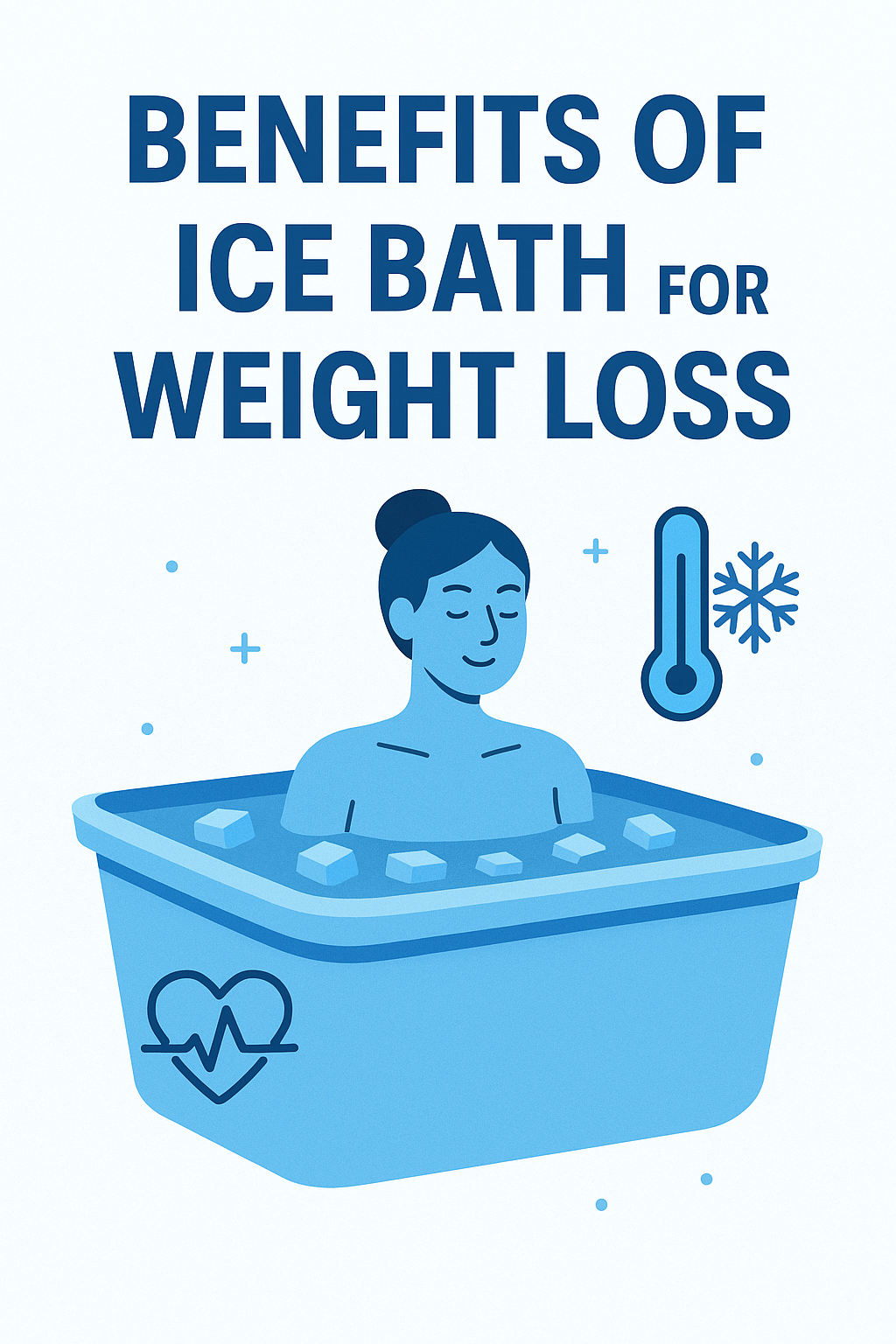Disclaimer
This article is for informational purposes only and should not be taken as medical advice. Ice baths and other forms of cold therapy may not be suitable for everyone. Individuals with medical conditions such as heart disease, high blood pressure, diabetes, or circulatory disorders should consult a qualified healthcare professional before attempting cold-water immersion.
Ice baths have long been a recovery ritual for athletes and fitness enthusiasts, but lately, they’ve gained attention for something beyond sore muscles — potential weight loss. The idea is simple: when your body is exposed to cold, it works harder to maintain its core temperature, burning more calories in the process.
But is it really that straightforward? While social media trends glorify ice plunges as a quick fat-burning hack, the real science tells a more nuanced story. Ice baths can indeed trigger metabolic responses that aid weight management, but they work best as a supportive practice — not a standalone solution.
In this article, we’ll explore how ice baths affect your metabolism, the benefits they may offer for weight loss, and how to use them safely as part of a balanced fitness plan.
What Is an Ice Bath and How It Works
Understanding the Concept
An ice bath, also called cold-water immersion therapy, involves immersing your body in chilled water, typically maintained between 50–59°F (10–15°C). This method has been used for decades by athletes to ease muscle soreness and speed up recovery after intense workouts.
The Physiological Response
When your body comes in contact with cold water, several physiological changes occur. Your blood vessels narrow (vasoconstriction) to conserve body heat and reduce inflammation. Once you step out and start to warm up, blood vessels dilate (vasodilation), improving circulation and helping flush out metabolic waste.
Connection to Weight Loss
Beyond recovery, ice baths may influence metabolism. Cold exposure triggers brown adipose tissue (BAT) — a type of fat that burns calories to produce heat. This process, known as thermogenesis, helps increase energy expenditure, which can support gradual weight loss when paired with healthy diet and exercise habits.
The Science Behind Ice Baths and Weight Loss
Activation of Brown Adipose Tissue (BAT)
Brown adipose tissue, or brown fat, is metabolically active fat that burns calories to produce heat — a process known as non-shivering thermogenesis. Exposure to cold water stimulates this tissue, prompting your body to use stored energy for warmth. Over time, regular cold exposure may slightly increase overall calorie burn and metabolic rate.
Impact on Metabolism
When the body faces cold stress, it works harder to maintain core temperature. This leads to a temporary boost in metabolic activity, causing your system to use more energy than usual. While the calorie burn from a single ice bath session is modest, consistent exposure may contribute to long-term metabolic adaptation.
Hormonal and Nervous System Response
Cold exposure activates the sympathetic nervous system, increasing the release of norepinephrine, a hormone that enhances alertness, fat metabolism, and energy use. This hormonal response, combined with thermogenesis, can create a favorable environment for fat utilization when integrated into a balanced lifestyle.
Scientific Evidence and Limitations
Research supports the idea that ice baths stimulate brown fat and raise energy expenditure, but the effects are often modest and variable among individuals. Ice baths alone are unlikely to cause significant weight loss — their benefits are best realized when combined with regular physical activity, proper nutrition, and recovery routines.
Key Benefits of Ice Baths for Weight Loss
1. Stimulates Metabolism
When exposed to cold, your body works to maintain its internal temperature by burning stored energy. This thermogenic effect slightly raises your resting metabolic rate, helping you expend more calories even after leaving the ice bath. While the increase isn’t dramatic, consistent cold exposure can support gradual fat loss over time.
2. Enhances Muscle Recovery
Ice baths help reduce muscle soreness and inflammation after workouts by improving circulation once you warm up. This means you can train more frequently and recover faster, which indirectly supports weight loss by maintaining workout consistency.
3. Reduces Inflammation and Fatigue
Cold immersion lowers swelling and muscle fatigue, leading to better performance in subsequent workouts. Over time, this allows for more intense physical activity — a crucial component of effective weight management.
4. Supports Better Sleep and Hormonal Balance
Cold exposure before bedtime can promote relaxation and improve sleep quality by lowering your core temperature. Quality sleep is vital for regulating hormones like cortisol and leptin, both of which influence appetite, metabolism, and fat storage.
5. Builds Mental Toughness and Discipline
Enduring the shock of cold water trains both mind and body. This mental resilience often translates into better consistency with workouts, nutrition, and other healthy lifestyle habits — all essential for sustainable weight loss.
How to Safely Try Ice Baths
Start Gradually
If you’re new to cold exposure, start slow. Begin with cool showers and gradually lower the temperature over time. Once you’re comfortable, progress to short ice bath sessions lasting 2–3 minutes, then slowly increase to 10–15 minutes as your tolerance improves.
Ideal Temperature and Duration
Maintain the water temperature between 50°F and 59°F (10°C–15°C). Staying longer or going colder doesn’t necessarily yield more benefits — instead, it increases the risk of hypothermia or shock. Short, consistent sessions are safer and more effective than pushing extreme limits.
Listen to Your Body
Your body’s response will vary depending on factors like age, fitness level, and health status. Step out immediately if you feel numbness, dizziness, or confusion. The goal is to challenge the body safely, not to endure discomfort.
Who Should Avoid Ice Baths
People with certain medical conditions should consult a doctor before trying cold immersion. Avoid ice baths if you have:
- Heart or blood pressure disorders
- Diabetes or neuropathy (reduced sensation in limbs)
- Raynaud’s disease
- Circulatory or respiratory problems
Practical Tips for Safe Practice
- Use a thermometer to monitor water temperature.
- Keep a timer to avoid overstaying.
- Have warm clothing or blankets ready post-bath.
- Practice deep, controlled breathing to manage the initial cold shock.
- Hydrate well before and after the session.
By easing into it mindfully, you’ll gain the benefits of ice baths safely and sustainably — without overstraining your body.
Other Health Benefits of Ice Baths (Beyond Weight Loss)
Improves Circulation
Alternating between cold and warm environments — as happens before and after an ice bath — strengthens your cardiovascular system. When blood vessels constrict in the cold and dilate as you warm up, this improves overall circulation and supports heart health.
Reduces Muscle Soreness and Speeds Recovery
Ice baths help flush out lactic acid and other waste products built up during intense exercise. This leads to faster recovery, reduced stiffness, and a quicker return to training. Regular cold therapy can help athletes maintain consistent performance without overtraining.
Strengthens the Immune System
Cold exposure may stimulate white blood cell production, improving your body’s ability to fight infections. Over time, this can enhance general immunity and resilience against seasonal illnesses.
Promotes Mental Clarity and Mood
The sudden cold shock triggers the release of endorphins — the body’s natural “feel-good” hormones. Many people report improved mood, reduced anxiety, and sharper focus after ice baths.
Supports Stress Management
Immersing in cold water activates the vagus nerve, which helps regulate stress responses and promotes calmness. Practicing this regularly can help improve emotional control and resilience under pressure.
While these benefits don’t directly cause weight loss, they contribute to a healthier, more balanced lifestyle, making it easier to maintain habits that support long-term fitness and well-being.
Are Ice Baths Alone Enough for Weight Loss?
The Truth About Ice Baths and Fat Burning
While ice baths can slightly increase calorie expenditure by activating brown fat and boosting metabolism, they are not a primary weight loss method. The number of calories burned during a single session is relatively small — not enough to replace the benefits of consistent exercise and proper nutrition.
The Role of Diet and Exercise
For sustainable results, cold therapy should be paired with a balanced diet and regular physical activity. Ice baths can enhance recovery, allowing you to train harder and more often, but real fat loss comes from a sustained calorie deficit and active lifestyle.
Supportive Benefits in a Weight Loss Plan
Ice baths can complement your fitness routine by:
- Improving post-workout recovery so you can stay consistent.
- Helping control inflammation and muscle soreness.
- Supporting hormonal balance for better sleep and appetite control.
When to Expect Results
Consistency matters more than duration or extreme temperatures. Even short, regular cold exposures — when combined with healthy eating and exercise — can help you feel more energetic, focused, and resilient, creating the foundation for long-term progress.
In short, ice baths are best viewed as a supportive wellness tool, not a shortcut to weight loss. They enhance recovery and metabolic health, helping you stay on track with the habits that truly make a difference.
Final Thoughts
Ice baths can be a valuable addition to a healthy lifestyle, offering benefits that go beyond the cold shock. They may help stimulate metabolism, improve recovery, reduce inflammation, and enhance mental resilience — all of which indirectly support weight loss. However, they should be seen as a complement, not a replacement, for proper diet and exercise.
If you decide to include ice baths in your wellness routine, start slowly, pay attention to how your body responds, and always prioritize safety. For most people, short sessions at moderate temperatures are more than enough to gain the benefits without risking cold-related injury.
Ultimately, the key to effective weight loss remains a combination of nutrition, consistent movement, quality sleep, and stress management. Ice baths can play a supportive role by helping you recover faster, stay consistent with training, and strengthen your discipline — all important building blocks for lasting health and fitness.

